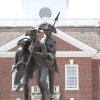Jack Lewis, Gilbert Byron, nostalgia and our times
I write from time to time about crisscrossing Delmarva novelist and poet Gilbert Byron. His life totally dedicated to literature took him from Chestertown to Dover to Lewes and eventually to a hand-built cottage on Old House Cove, San Domingo Creek, St. Michaels.
We spoke one day in his humble dwelling, his vision clouded by his 80 or so years, but his mind still sharp, inquisitive, and - at that point in his life - reflective.
On the subject of writing he made a comment that felt simple at the time, but somehow has stuck with me.
“I’ve concluded that nostalgia is not enough,” he said. We were discussing his most highly acclaimed novel The Lord’s Oysters and a sequel called Done Crabbin’ that took him a long time to complete. Noah, the boyhood protagonist in The Lord’s Oysters, remained the center of Byron’s next novel, but as a college graduate and adult moving out of innocence and into a different, more complicated era.
Byron’s nostalgia comment felt to me like resignation mixed with a dose of self-indictment for not having reached greater heights. Not an uncommon trait for we humans as aspirational beings. “I coulda been a contender.”
But in these confused and uncertain times, nostalgia and its comfort of selective memory offer us the illusion of a safer harbor, even though it's not one our compass can lead us toward.
A nostalgic scene from days of yore on Delmarva greeted me this week when I opened the pages of The Chesapeake Bay Scene by artist Jack Lewis. Lewis illustrated some of Byron’s poetry collections. In turn, Lewis sprinkled a number of Byron’s poems throughout his Chesapeake book which includes many of his paintings and drawings. They represent scenes of the people, towns and villages of the tidewater region, reproduced in color and black and white.
Lewis’s limited edition book was published first in 1947, with a second edition - dedicated to his friend Gilbert - published in 1970.
It’s the kind of book you find occasionally in used book stores and at auctions, along with Lewis’s paintings. I’ve owned one of the books, along with another by Lewis called The Delaware Scene, for decades.
In keeping with the craziness of the times, Becky and I are moving for the second time in 10 months, from one side of Grace Creek - in Bozman, Md. - to the other.
Moving leads to lots of winnowing and a significantly shrunken library. Boxes of books are heavy! But Byron’s and Lewis’s books have made the cut.
Unpacking The Chesapeake Bay Scene one more time led me to open its pages and once again discover its many gems.
The Lewis scenes feel nostalgic now but they were anything but nostalgic when Lewis first produced them along with his engaging, pithy and well-crafted commentary. Each drawing and painting is accompanied by three short paragraphs, in three categories: Human Interest, Composition, Philosophy.
The painting at the top of this piece is titled Store at Earleville, from Maryland’s Cecil County, at the top of the peninsula.
Its commentary provides a good taste of Lewis’s style and insight. It also captures a bit of what I’m feeling in this moving time.
Under Human Interest for this painting, Lewis wrote:
“Goosy Buxom sat at one side of the store. In a discussion of politics, Goosy was heard to remark; ‘Boys, I don’t know your politics, but I do know this: be one thing or the other. The Democrats can get some scoundrels in, and the Republicans can get some scoundrels in. Vote for one, anyway. Some government is better than no government at all.’
He said ‘Drink it! It’ll do you good!’ I answered him and said ‘It won’t do me no good ‘cause I feel good already.’”
Under Composition Lewis wrote:
“There is something striking about the order of things placed in rows in a general store. In this sort of store there seems to be no hurry to sell. The people who come in become expansive and friendly. They are orderly, cheered by the effect upon themselves or rows of this and that - all put away on the shelves.”
And under Philosophy: “Could it not be that they congregated in old stores because they feel relieved that everything is put away, work is all done, and they will not be called upon to do this? Aside from the companionship, here, at least, is a place free ‘of putting things away.’”
This all makes me think that the mind of the artist bubbles with all kinds of thoughts while he or she goes about their task. What a meditation.






















































